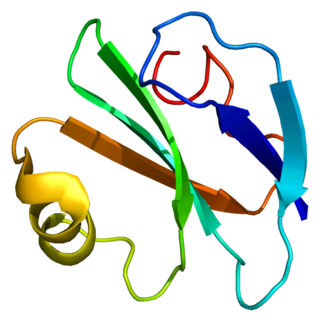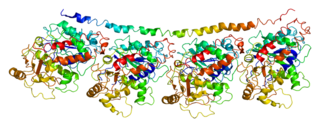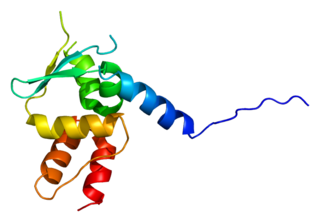
Lipid signaling, broadly defined, refers to any biological cell signaling event involving a lipid messenger that binds a protein target, such as a receptor, kinase or phosphatase, which in turn mediate the effects of these lipids on specific cellular responses. Lipid signaling is thought to be qualitatively different from other classical signaling paradigms because lipids can freely diffuse through membranes. One consequence of this is that lipid messengers cannot be stored in vesicles prior to release and so are often biosynthesized "on demand" at their intended site of action. As such, many lipid signaling molecules cannot circulate freely in solution but, rather, exist bound to special carrier proteins in serum.

Hippocalcin is a protein that in humans is encoded by the HPCA gene.
Organophosphate-induced delayed neuropathy (OPIDN), also called organophosphate-induced delayed polyneuropathy (OPIDP), is a neuropathy caused by killing of neurons in the central nervous system, especially in the spinal cord, as a result of acute or chronic organophosphate poisoning.

Phospholipase A1 (EC 3.1.1.32; systematic name: phosphatidylcholine 1-acylhydrolase) encoded by the PLA1A gene is a phospholipase enzyme which removes the 1-acyl group:

CD59 glycoprotein, also known as MAC-inhibitory protein (MAC-IP), membrane inhibitor of reactive lysis (MIRL), or protectin, is a protein that in humans is encoded by the CD59 gene. It is an LU domain and belongs to the LY6/uPAR/alpha-neurotoxin protein family.
The enzyme lysophospholipase (EC 3.1.1.5) catalyzes the reaction

Phospholipase A2, membrane associated is an enzyme that in humans is encoded by the PLA2G2A gene.

85 kDa calcium-independent phospholipase A2, also known as 85/88 kDa calcium-independent phospholipase A2, Group VI phospholipase A2, Intracellular membrane-associated calcium-independent phospholipase A2 beta, or Patatin-like phospholipase domain-containing protein 9 is an enzyme that in humans is encoded by the PLA2G6 gene.

40S ribosomal protein S27a is a protein that in humans is encoded by the RPS27A gene.

1-Phosphatidylinositol-4,5-bisphosphate phosphodiesterase delta-1 is an enzyme that in humans is encoded by the PLCD1 gene. PLCd1 is essential to maintain homeostasis of the skin.

ADP-ribosylation factor 3 is a protein that in humans is encoded by the ARF3 gene.

Regulator of G-protein signaling 3 is a protein that in humans is encoded by the RGS3 gene.

Tubulin alpha-1C chain is a protein that in humans is encoded by the TUBA1C gene.

Group 10 secretory phospholipase A2 is an enzyme that in humans is encoded by the PLA2G10 gene.

Ubiquilin-2 is a protein that in humans is encoded by the UBQLN2 gene.

Neuronal acetylcholine receptor subunit alpha-5, also known as nAChRα5, is a protein that in humans is encoded by the CHRNA5 gene. The protein encoded by this gene is a subunit of certain nicotinic acetylcholine receptors (nAchR).

Transcription cofactor HES-6 is a protein that in humans is encoded by the HES6 gene.

Gigaxonin also known as kelch-like protein 16 is a protein that in humans is encoded by the GAN gene.

Calcium-independent phospholipase A2-gamma is an enzyme that in humans is encoded by the PNPLA8 gene.

2-acyl-sn-glycero-3-phosphocholines are a class of phospholipids that are intermediates in the metabolism of lipids. Because they result from the hydrolysis of an acyl group from the sn-1 position of phosphatidylcholine, they are also called 1-lysophosphatidylcholine. The synthesis of phosphatidylcholines with specific fatty acids occurs through the synthesis of 1-lysoPC. The formation of various other lipids generates 1-lysoPC as a by-product.






















